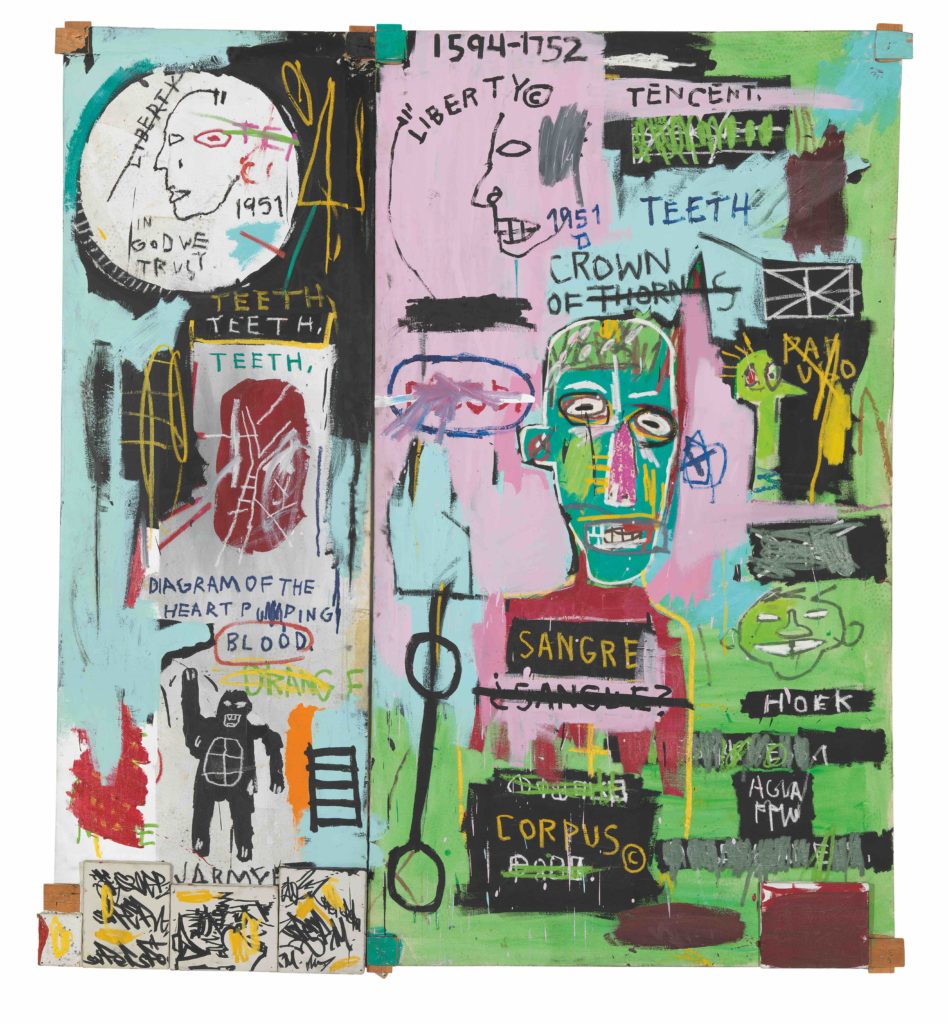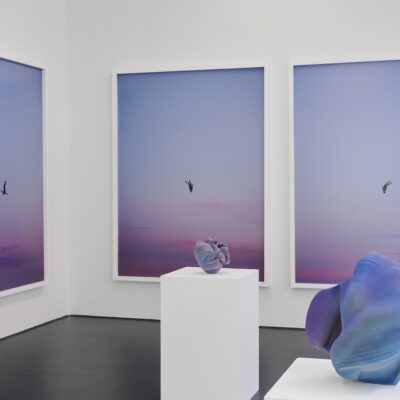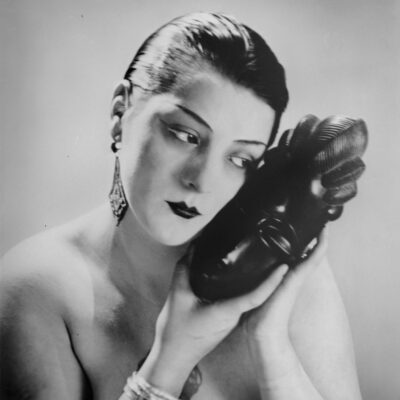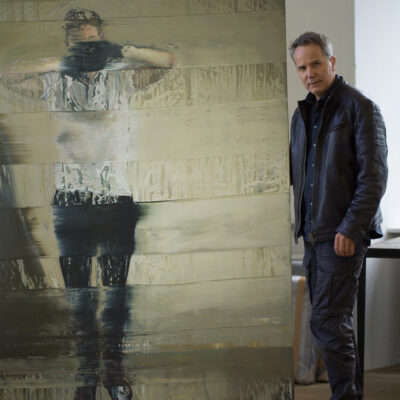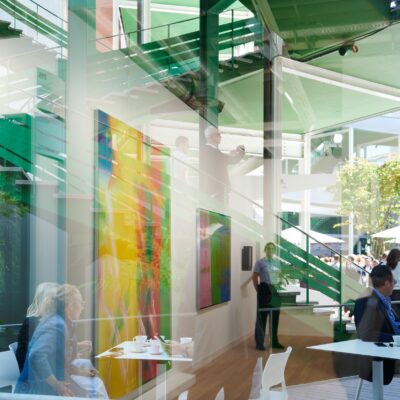The Jean-Michel Basquiat exhibition at Louis Vuitton Foundation in Paris features 120 defining works from Basquiat’s career, spanning from 1980 to 1988, shown over four floors of the Frank Gehry-designed museum. Many of the most important paintings that Basquiat made in his short but prolific career are on display.
Basquiat grew up in a townhouse in Brooklyn with a Puerto Rican-American mother and a Haitian father. As a child he visited museums with his mother, an amateur artist. Basquiat moved out from the family home in 1978, at age 17, to the East Village, an epicenter of creativity at that time, to become an artist. The film “The Radiant Child” documents Basquiat’s early days in New York, living on the street and staying with friends, while trying to break into the art scene. Basquiat first became known as a word-based graffiti artist with the name “SAMO” as in “same old sh_t”. At this early stage in his career, he began painting on found objects including doors, pieces of canvas, and tiles since he couldn’t afford art materials.
In 1980, he was part of the Times Square Show, a group show with work by Keith Haring and Kenny Scharf, among others. By 1981, he was invited to show his work at the New York/New Wave group show at P.S. 1, where it was seen by gallery-owner Annina Nosei. Subsequently, he was invited to be part of a group show at Nosei’s gallery at 100 Prince Street in SOHO, and, knowing that he didn’t have a studio, she gave him space to work in the gallery basement. This was the beginning of a meteoric career.

In this early piece titled Pork, painting on a door, Basquiat uses the words Pork, 10 p Peso Neto and Tar. Basquiat often listened to the radio or tv with a pile of books to look through for inspiration while he painted. He liked to repeat words and cross some of them off to bring attention to them, and words formed an important element of his work. In “The Radiant Child” by Rene Ricard, (Artforum Magazine, December, 1981), he says “One or two words on a Jean-Michel contain the entire history of graffiti. What he incorporates into his pictures, whether found or made, is specific and selective. He has a perfect idea of what he’s getting across, using everything that collates to his vision.”
Johnny Depp acquired Pork in 1998 at a Christie’s auction, and he wrote about it for Enrico Navarra’s book “Jean-Michel Basquiat” (Paris, 2000), stating “…we can begin by saying that Basquiat is not for everyone. Much like pork is not for everyone. You either get it, or you don’t. One either loves with a passion, or despises with a vengeance. I’ve never heard of anyone saying, “Well, he’s ok I guess…”. No, to my knowledge that doesn’t happen with Basquiat.”

Also shown early in the exhibition is one of the most famous Basquiat paintings at this point in time, Untitled, 1982. It was bought by a Japanese collector, Yusaku Maezawa, for a record $110.5 million at a Sotheby’s auction in May, 2017. This is the second Basquiat that Maezawa has bought at auction, the first was another untitled work that he bought for $57.3 million in May, 2016. Maezawa plans to open a museum to showcase his collection in Chiba, Japan. In the meantime, the Untitled 1982 painting is on a world-tour sponsored by Maezawa, who said in New York Times interview that “I want to show beautiful things and share them with everyone.” (May 26, 2017)

This piece is an example of Basquiat’s neo-expressionist style, bringing energy and immediacy to the canvas. Painted in a loose style, letters are scribbled onto the canvas and then crossed out above the skull-like head. The background is seemingly unplanned, with layers of blue paint blotting out previous layers. The painting has a range of colours, from bright blue, red and yellow to pale grey and pink. Centered in the middle of the painting is a large, black skull with bared teeth; the look on the face is tortured. The piece is full of creative energy and angst; it is unmistakably a Basquiat.

The exhibition wall statement next to Obnoxious Liberals says “Both the collective and his personal experience with racism touched him profoundly: his heroes, saints and martyrs standing against it, it is impossible not to identify the artist himself with these figures.” In this painting, the biblical figure of Samson is shown chained between two white columns. His hair, the source of his power, has been cut off. In the middle is a man with the label “Obnoxious Liberals” written above him, and “Not For Sale” written below. Above him is a three-pointed crown, a symbol often seen in Basquiat’s work. Ricard said “the crown sits securely on the head of Jean-Michel’s repertory so that it is of no importance where he got it, bought it, stole it: it’s his.” His friend, artist Francesco Clemente, said that “Jean-Michel’s crown has three peaks, for his three royal lineages: the poet, the musician, the great boxing champion,” (Sotheby’s).
To the right, is a man in a cowboy hat with dollar signs around him and pink skin. This figure represents the art patrons. His ex-girlfriend, Suzanne Mallouk, said in an interview in “The Radiant Child” that if Basquiat didn’t like a collector, then he would throw them out of the loft, and pour milk or food on them out of the window of the building. As his success grew, Basquiat was in a system where he wanted and needed to sell his work, however, it could conflict with his values.

This painting exhibits many of the symbols Basquiat used in his work. Titled In Italian, this is mysterious since only one word in the painting is actually in Italian, Sangue (blood) which is crossed out, and the Latin word for blood (Sangre) is written in its place. The words “Crown of Thorns”, with “Thorns” crossed out, appears, a common reference in Basquiat’s work. A diagram of the heart pumping blood and the word Corpus or body refers back to Basquiat’s focus on anatomy. Basquiat was given Gray’s Anatomy by his mother while recovering in hospital after being hit by a car as a child, and he cited this book as a source for the skeletal figures and anatomical drawings in his work.
In addition, Basquiat uses large patches of mint green, light blue and pink as the overall background, which look like layers of paint peeling off a building. It is suggested that perhaps “In Italian” refers to the word “graffiti” which was originally an Italian word for drawing on Roman walls and later meaning vandalism. The many layers of meaning and combination of colours make for a fascinatingly-detailed piece.
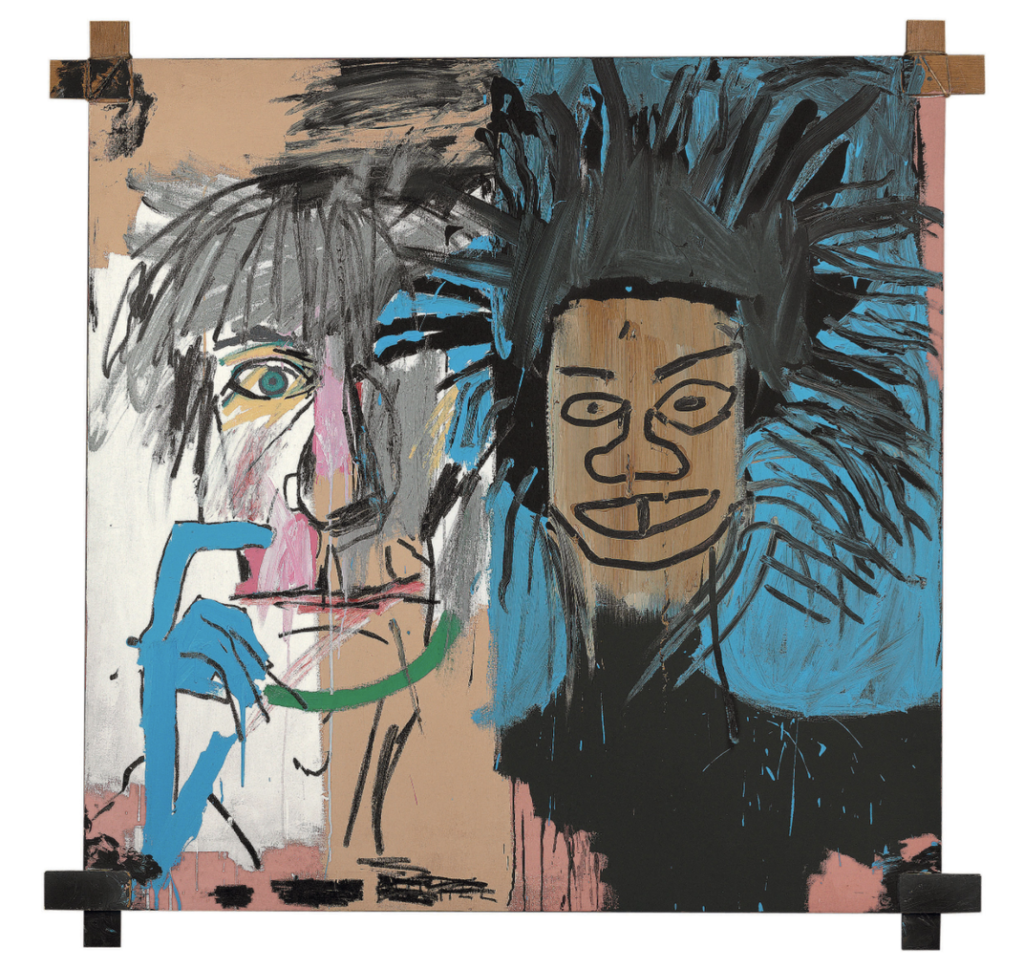
Basquiat was introduced to Warhol in 1982 by Zurich gallerist Bruno Bischofberger at lunch where a photo was taken of the two of them. Jean-Michel reportedly disappeared halfway through the lunch and returned with a huge painting, a double portrait based on the photograph. This was to become Dos Cabezas, a painting that represents the beginning of the two artist’s relationship. Both were masters of promoting themselves in the media and together formed a powerful team. Warhol and Basquiat went on to become close friends, with Warhol giving him advice, for example, on how to deal with fame. Basquiat said in The Radiant Child film “seeing how he dealt with things was the best part.” Basquiat’s former girlfriend Suzanne Mallouk said it was awkward for her relationship with Basquiat because “Warhol was in love with Basquiat”.
Bischofberger arranged a collaboration between the artists. Basquiat said that Warhol “would start most of the paintings and I would deface it. I would try to get him to do at least two things.” They had a show together called “Paintings” at the Tony Shafrazi Gallery in 1985. The show was a critical flop. Basquiat left the next day without saying anything to Warhol, cutting off their relationship. The death of Warhol on 22 February, 1987, after routine surgery, affected Basquiat deeply.

The painting Riding With Death was from Basquiat’s last exhibition and is one of his most important works. The imagery has been simplified to only two figures with a plain background. Gone are the repeated words and frenetic energy found in many of Basquiat’s earlier pieces. The painting references works by several old masters, most clearly that of Leonardo da Vinci’s “Two Allegories of Envy”. The subject is death, perhaps referencing Basquiat’s drug abuse and the likely outcome of that lifestyle. He died on April 12, 1988, of a heroin overdose.
Julian Schnabel stated in The Radiant Child, “He just didn’t have the tools to navigate through the sea of sh_t.” Annina Nosei (Christie’s, 2014) said that Basquiat was “interested in life and people and history and science. “There is no difference between low and high culture. It’s culture or it’s not culture”. Basquiat captured a time, place and culture with a singularly arresting artistic language. His art and his persona combined to create an unforgettable phenomena. The themes, creativity, and energy in his work still resonate and captivate people today, from the general public to the world’s top art collectors.
The exhibition ran from 3 October 2018 until 14 January 2019. This article was originally published in December, 2018.
